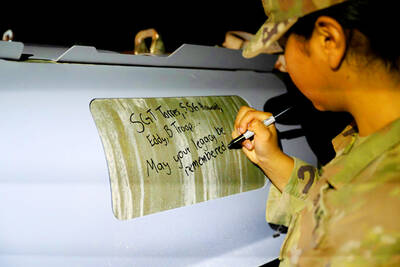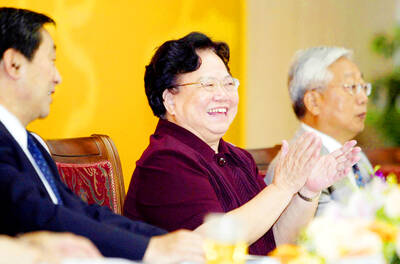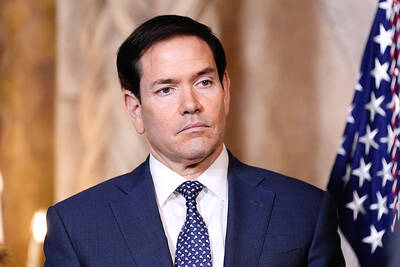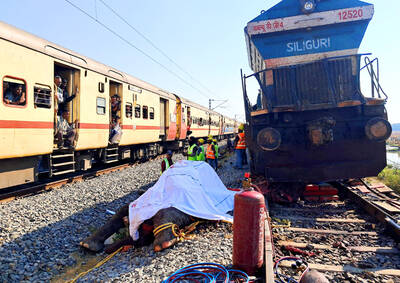Iraqis are once again leaving Iraq for Syria in greater numbers than they are returning, despite the decreasing levels of bloodshed in their homeland, the UN refugee agency said yesterday.
A report by the United Nations High Commissioner for Refugees (UNHCR), citing Syrian immigration officials, said that late last month, an average of 1,200 Iraqis came to Syria every day compared with around 700 who returned.
Most of those Iraqis who are returning say they are doing so more because their Syrian visas have expired or because they have run out of money, rather than because of an improvement in conditions in Iraq, the report said.
"The UNHCR has observed that the return movement to Iraq that increased immediately after the imposition of new visa regulations appears to have subsided," the report said.
The figures will disappoint Iraqi officials, who have pointed to a number of high-profile convoys of returning refugees as evidence that safety is returning to their war-torn cities after a year of battles with insurgents.
The UN estimates there are about 1.5 million Iraqis in Syria, including 153,516 who are formally registered as refugees from the conflict that has wracked their homeland since the US-led invasion of March 2003.
"According to an Iraqi Red Crescent report issued in January 2008, some 46,000 refugees returned home from Syria between September and December 2007, a much lower figure than that given by the Iraqi government," the report said.
The Iraqi government had given a figure of 60,000 returnees and invited reporters to homecoming ceremonies at which officials presented the refugees with gifts and boasted of the achievements of the Baghdad security plan.
mass grave
About 50 dead bodies were discovered on Tuesday in a mass grave northwest of Baghdad, Iraqi officials said.
US-backed Sunni tribesmen found the grave while patrolling the village of Jazeerah, 25km west of Samarra near Lake Tharthar, said Colonel Mazin Younis Hussein, the commander of the Samarra support force, a group of local men working with US forces.
Some of the bodies were severely decomposed, suggesting they had been buried months ago, while other victims appeared to have been killed recently, said Samarra police Lieutenant Muthanna Shakir, who visited the site on Tuesday and saw the bodies.
The US military in northern Iraq said it had no information about the discovery of a mass grave in the area.
As many as 200 bodies have been unearthed in recent months from mass graves around Lake Tharthar. Al-Qaeda in Iraq controlled the area, as well as huge swaths of Iraq's western deserts, until being ousted early this year in an uprising by local tribes.
In other developments, a new Iraqi flag -- stripped of the three green stars of the late Saddam Hussein's toppled Baath Party -- was hoisted over the Iraqi Cabinet building on Tuesday in a symbolic break with the past nearly five years after the US-led invasion.
new Iraqi flag
The new flag marked the latest of several tweaks and revisions -- and one failed US-crafted redesign -- of Iraq's national symbol over the decades from monarchy to military rule to the rise and fall of Saddam's regime. And more fine-tuning could come after the one-year lifespan ends for the new flag.
Its main modification removes the stars, which were first added in the early 1960s in homage to the pan-Arab bonds promoted by Egypt's Gamal Abdel Nasser. Later, the green stars were associated with the slogans of Saddam's party: unity, freedom and socialism.
The new design also officially enshrines the new script for the Arabic words Allahu Akbar, or "God is Great" in green -- which were added after Saddam's 1990 to 1991 occupation of Kuwait. The original calligraphy -- believed inspired by Saddam's handwriting -- was replaced with the sparse Kufic script after his fall in 2003. But many houses continued to fly the old flag.
"It is a good step toward the new Iraq," said Nassih Gahfour, a lawmaker in northern Iraq's semiautonomous Kurdish area, where officials had demanded the changes and threatened not to fly the flag while hosting a meeting of Arab parliament members later this month.

REVENGE: Trump said he had the support of the Syrian government for the strikes, which took place in response to an Islamic State attack on US soldiers last week The US launched large-scale airstrikes on more than 70 targets across Syria, the Pentagon said on Friday, fulfilling US President Donald Trump’s vow to strike back after the killing of two US soldiers. “This is not the beginning of a war — it is a declaration of vengeance,” US Secretary of Defense Pete Hegseth wrote on social media. “Today, we hunted and we killed our enemies. Lots of them. And we will continue.” The US Central Command said that fighter jets, attack helicopters and artillery targeted ISIS infrastructure and weapon sites. “All terrorists who are evil enough to attack Americans are hereby warned

The death of a former head of China’s one-child policy has been met not by tributes, but by castigation of the abandoned policy on social media this week. State media praised Peng Peiyun (彭珮雲), former head of China’s National Family Planning Commission from 1988 to 1998, as “an outstanding leader” in her work related to women and children. The reaction on Chinese social media to Peng’s death in Beijing on Sunday, just shy of her 96th birthday, was less positive. “Those children who were lost, naked, are waiting for you over there” in the afterlife, one person posted on China’s Sina Weibo platform. China’s

‘POLITICAL LOYALTY’: The move breaks with decades of precedent among US administrations, which have tended to leave career ambassadors in their posts US President Donald Trump’s administration has ordered dozens of US ambassadors to step down, people familiar with the matter said, a precedent-breaking recall that would leave embassies abroad without US Senate-confirmed leadership. The envoys, career diplomats who were almost all named to their jobs under former US president Joe Biden, were told over the phone in the past few days they needed to depart in the next few weeks, the people said. They would not be fired, but finding new roles would be a challenge given that many are far along in their careers and opportunities for senior diplomats can

Seven wild Asiatic elephants were killed and a calf was injured when a high-speed passenger train collided with a herd crossing the tracks in India’s northeastern state of Assam early yesterday, local authorities said. The train driver spotted the herd of about 100 elephants and used the emergency brakes, but the train still hit some of the animals, Indian Railways spokesman Kapinjal Kishore Sharma told reporters. Five train coaches and the engine derailed following the impact, but there were no human casualties, Sharma said. Veterinarians carried out autopsies on the dead elephants, which were to be buried later in the day. The accident site